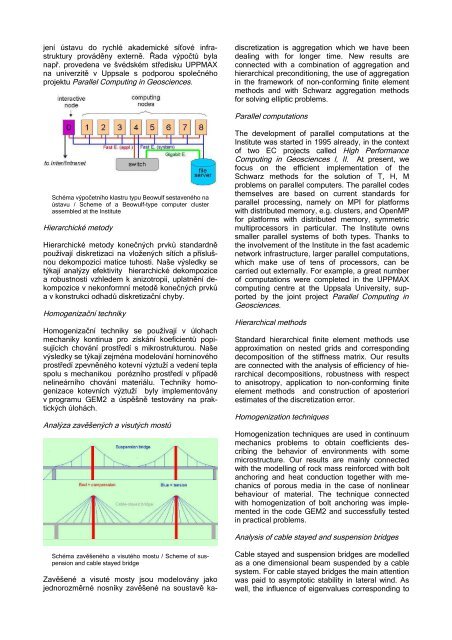Ústav geoniky AV ČR, v.v.i. Institute of Geonics AS CR, v.v.i. 25
Ústav geoniky AV ČR, v.v.i. Institute of Geonics AS CR, v.v.i. 25
Ústav geoniky AV ČR, v.v.i. Institute of Geonics AS CR, v.v.i. 25
Create successful ePaper yourself
Turn your PDF publications into a flip-book with our unique Google optimized e-Paper software.
jení ústavu do rychlé akademické síťové infrastruktury<br />
prováděny externě. Řada výpočtů byla<br />
např. provedena ve švédském středisku UPPMAX<br />
na univerzitě v Uppsale s podporou společného<br />
projektu Parallel Computing in Geosciences.<br />
Schéma výpočetního klastru typu Beowulf sestaveného na<br />
ústavu / Scheme <strong>of</strong> a Beowulf-type computer cluster<br />
assembled at the <strong>Institute</strong><br />
Hierarchické metody<br />
Hierarchické metody konečných prvků standardně<br />
používají diskretizaci na vložených sítích a příslušnou<br />
dekompozici matice tuhosti. Naše výsledky se<br />
týkají analýzy efektivity hierarchické dekompozice<br />
a robustnosti vzhledem k anizotropii, uplatnění dekompozice<br />
v nekonformní metodě konečných prvků<br />
a v konstrukci odhadů diskretizační chyby.<br />
Homogenizační techniky<br />
Homogenizační techniky se používají v úlohach<br />
mechaniky kontinua pro získání koeficientů popisujících<br />
chování prostředí s mikrostrukturou. Naše<br />
výsledky se týkají zejména modelování horninového<br />
prostředí zpevněného kotevní výztuží a vedení tepla<br />
spolu s mechanikou porézního prostředí v případě<br />
nelineárního chování materiálu. Techniky homogenizace<br />
kotevních výztuží byly implementovány<br />
v programu GEM2 a úspěšně testovány na praktických<br />
úlohách.<br />
Analýza zavěšených a visutých mostů<br />
Schéma zavěšeného a visutého mostu / Scheme <strong>of</strong> suspension<br />
and cable stayed bridge<br />
Zavěšené a visuté mosty jsou modelovány jako<br />
jednorozměrné nosníky zavěšené na soustavě ka-<br />
discretization is aggregation which we have been<br />
dealing with for longer time. New results are<br />
connected with a combination <strong>of</strong> aggregation and<br />
hierarchical preconditioning, the use <strong>of</strong> aggregation<br />
in the framework <strong>of</strong> non-conforming finite element<br />
methods and with Schwarz aggregation methods<br />
for solving elliptic problems.<br />
Parallel computations<br />
The development <strong>of</strong> parallel computations at the<br />
<strong>Institute</strong> was started in 1995 already, in the context<br />
<strong>of</strong> two EC projects called High Performance<br />
Computing in Geosciences I, II. At present, we<br />
focus on the efficient implementation <strong>of</strong> the<br />
Schwarz methods for the solution <strong>of</strong> T, H, M<br />
problems on parallel computers. The parallel codes<br />
themselves are based on current standards for<br />
parallel processing, namely on MPI for platforms<br />
with distributed memory, e.g. clusters, and OpenMP<br />
for platforms with distributed memory, symmetric<br />
multiprocessors in particular. The <strong>Institute</strong> owns<br />
smaller parallel systems <strong>of</strong> both types. Thanks to<br />
the involvement <strong>of</strong> the <strong>Institute</strong> in the fast academic<br />
network infrastructure, larger parallel computations,<br />
which make use <strong>of</strong> tens <strong>of</strong> processors, can be<br />
carried out externally. For example, a great number<br />
<strong>of</strong> computations were completed in the UPPMAX<br />
computing centre at the Uppsala University, supported<br />
by the joint project Parallel Computing in<br />
Geosciences.<br />
Hierarchical methods<br />
Standard hierarchical finite element methods use<br />
approximation on nested grids and corresponding<br />
decomposition <strong>of</strong> the stiffness matrix. Our results<br />
are connected with the analysis <strong>of</strong> efficiency <strong>of</strong> hierarchical<br />
decompositions, robustness with respect<br />
to anisotropy, application to non-conforming finite<br />
element methods and construction <strong>of</strong> aposteriori<br />
estimates <strong>of</strong> the discretization error.<br />
Homogenization techniques<br />
Homogenization techniques are used in continuum<br />
mechanics problems to obtain coefficients describing<br />
the behavior <strong>of</strong> environments with some<br />
microstructure. Our results are mainly connected<br />
with the modelling <strong>of</strong> rock mass reinforced with bolt<br />
anchoring and heat conduction together with mechanics<br />
<strong>of</strong> porous media in the case <strong>of</strong> nonlinear<br />
behaviour <strong>of</strong> material. The technique connected<br />
with homogenization <strong>of</strong> bolt anchoring was implemented<br />
in the code GEM2 and successfully tested<br />
in practical problems.<br />
Analysis <strong>of</strong> cable stayed and suspension bridges<br />
Cable stayed and suspension bridges are modelled<br />
as a one dimensional beam suspended by a cable<br />
system. For cable stayed bridges the main attention<br />
was paid to asymptotic stability in lateral wind. As<br />
well, the influence <strong>of</strong> eigenvalues corresponding to


